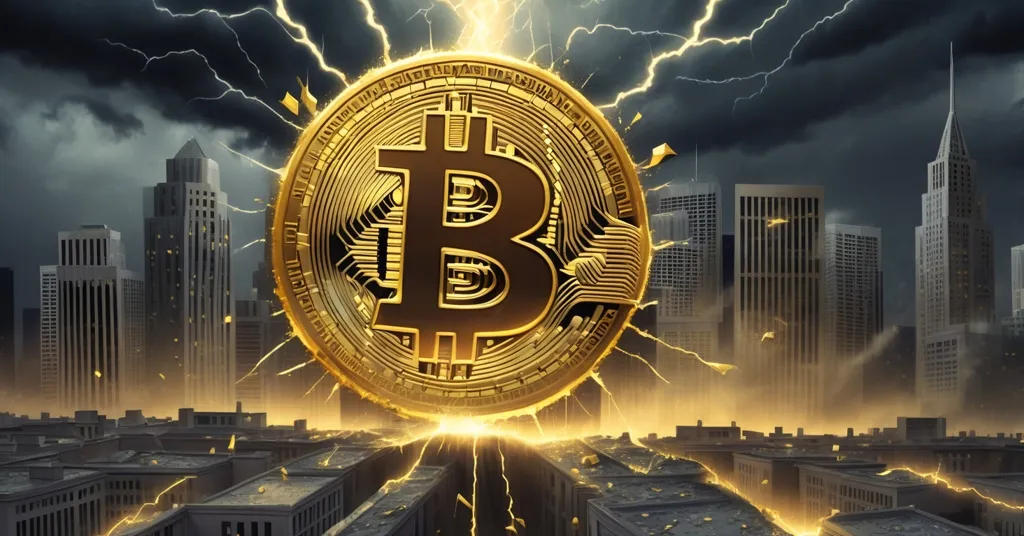Bitcoin to $200K Under Trump’s Dovish Fed Chair? Novogratz Warns of Economic Chaos

Mike Novogratz: Bitcoin Could Hit $200K if Trump Appoints Dovish Fed Chair—At What Cost?
Bitcoin might be gearing up for a jaw-dropping surge to $200,000, but the catalyst could be a political bombshell that shakes the U.S. economy to its core. Mike Novogratz, CEO of Galaxy Digital, dropped this bombshell during a recent interview, tying Bitcoin’s potential moonshot to President Donald Trump appointing a dovish Federal Reserve chair willing to slash interest rates with reckless abandon. While this could turbocharge crypto markets, Novogratz warns it might also tank America’s financial stability.
- Price Forecast: Bitcoin could soar to $200,000 with a dovish Fed chair under Trump.
- Economic Warning: Such a move risks gutting Fed independence and weakening the dollar.
- Market Chaos: Overheated equities and recent rate cuts set a volatile stage for crypto’s rally.
Novogratz’s Bold Call on Bitcoin’s Future
Speaking with Kyle Chasse on YouTube, Novogratz didn’t mince words about the potential for Bitcoin and the wider cryptocurrency market to explode if Trump reshapes the Federal Reserve. He called the appointment of a rate-slashing loyalist “the potential biggest bull catalyst for Bitcoin and the rest of crypto.” But his excitement for digital assets comes with a heavy dose of caution. “Do I want it to happen? No. Why? Because I kind of love America,” he admitted, underscoring the dangerous tradeoff between crypto gains and national economic health. You can find more on his perspective in this detailed discussion on Bitcoin potentially reaching $200K under a Trump-appointed Fed chair.
“Can Bitcoin get to $200K? Of course it could… Because it becomes a whole new conversation if that happens.” – Mike Novogratz
His prediction hinges on a seismic shift in monetary policy. A dovish Fed chair—someone who prioritizes low interest rates to boost growth, even if it sparks inflation—could weaken the dollar, sending investors scrambling for alternatives like Bitcoin. “Gold skyrockets… Bitcoin skyrockets,” Novogratz envisioned, framing crypto as a safe haven in a storm of currency devaluation. Yet, he’s clear-eyed about the chaos: “I don’t think the market will buy that Trump’s going to do the crazy, until he does the crazy.”
Fed Under Fire: Trump’s Potential Picks
For the uninitiated, the Federal Reserve, or Fed, is the U.S. central bank that decides how much it costs to borrow money through interest rates—a lever that impacts everything from your car loan to Wall Street’s mood swings. Its independence from political meddling has been a cornerstone of economic trust, keeping decisions free from election-year stunts. Trump, however, has long griped about current Fed Chair Jerome Powell, slamming him for not being loose enough with money during his presidency. Now, rumors are flying about Powell’s replacement, with Trump narrowing his shortlist to three names as of September 6: Kevin Hassett, Christopher Waller, and Kevin Warsh. “You could say those are the top three,” Trump confirmed, hinting at a potential shift when Powell’s term nears its end.
Let’s unpack the contenders. Kevin Hassett, a former Trump economic advisor, has a track record of favoring growth-friendly policies, often at the expense of fiscal caution—think printing money to juice the economy. Christopher Waller, already on the Fed Board of Governors, pushed for a rate cut back in July, well before the Fed’s recent 25 basis point drop (that’s a small tweak, where 100 basis points equals 1%). His dovish leanings could be catnip for crypto markets craving cheap money. Kevin Warsh, a former Fed governor, has criticized past Fed overreach but remains a wildcard on how far he’d slash rates. Each pick carries a flavor of deference to Trump’s agenda, raising alarms about the Fed becoming a political pawn.
Bitcoin Boom: Why $200K?
So, why does a dovish Fed chair spell a Bitcoin price forecast of $200,000? It’s about the dollar losing its grip. Lower interest rates make holding cash less appealing—why park money in a savings account yielding peanuts when prices are rising? Investors hunt for better returns or hedges against inflation, where Bitcoin shines as “digital gold.” Unlike fiat currency, which governments can print endlessly, Bitcoin’s supply is capped at 21 million coins, secured by blockchain—a tamper-proof ledger spread across thousands of computers worldwide. When the dollar weakens, Bitcoin’s value often climbs as a store of wealth, much like gold has for centuries.
History backs this up. During the 2020 COVID crisis, the Fed slashed rates to near zero and pumped trillions into the economy. Bitcoin responded by rocketing from under $10,000 to nearly $69,000 by late 2021, as investors fled a devaluing dollar. Novogratz sees a repeat if Trump’s pick floods the market with cheap cash, driving capital into decentralized assets. Compared to gold, Bitcoin’s borderless, digital nature could make it even more attractive to younger, tech-savvy investors. Tech stocks, meanwhile, might falter under inflation pressures, leaving crypto as a standout bet.
Economic Bust: The Dark Side of the Rally
Here’s the gut punch. A Bitcoin moonshot to $200,000 might mean you’re cashing out while the economy burns. Novogratz warns that a Fed chair bowing to political whims could shred decades of credibility, turning the dollar—the world’s reserve currency—into a punchline. The fallout? Skyrocketing inflation, where your grocery bill doubles overnight. Retirement funds could shrink as savings lose value. Mortgage rates might swing unpredictably, hammering homeowners. It’s not just theory; look at hyperinflation crises in places like Venezuela, where Bitcoin did surge as a lifeline, but only because the local currency collapsed.
As crypto advocates, we champion decentralization, but profiting off a house fire isn’t the win it seems. The S&P 500, up over 12% since January, already trades at a 41% premium to its 20-year average price-to-earnings ratio—think paying $100 for a $10 burger. Analysts like Sam Stovall of CFRA are skeptical: “Probably the oldest tenet in investing is ‘buy low, sell high.’” A dovish Fed could inflate this bubble further before it bursts, dragging down traditional markets while Bitcoin soars. The question looms: is a fat crypto wallet worth an economic crater?
Market Context and Crypto Wildcards
Zooming out, the financial backdrop is a tinderbox. The Fed’s recent 25 basis point rate cut—its first in a year—signals a pivot to looser policy, even under Powell’s cautious watch. As he noted, “We do look at overall financial conditions, and we ask ourselves whether our policies are affecting financial conditions in a way that is what we’re trying to achieve.” If “achieving” means drowning markets in cheap money under a Trump loyalist, volatility could spike. Wall Street’s acting like it’s playing Monopoly with real money—someone’s bound to land on ‘Go to Jail.’
Bitcoin itself isn’t immune to turbulence. Its price has swung wildly, crashing over 50% from its 2021 peak to 2022 lows on regulatory fears and macro headwinds. Adoption hurdles loom large: energy debates over mining’s carbon footprint, bans in markets like China, and hacks that plague the crypto wild west. Scammers and hype-driven nonsense about “$1M Bitcoin by tomorrow” don’t help—pure shilling we’ve got zero tolerance for. Meanwhile, altcoins like Ethereum power niches Bitcoin doesn’t touch, from smart contracts (self-executing code on blockchain) to DeFi (decentralized finance apps). A dovish Fed could lift all boats, but Bitcoin’s unique “digital gold” narrative might still outshine the pack for maximalists among us.
What’s Next for Crypto?
Beyond Fed drama, other triggers could shape Bitcoin’s trajectory. Spot ETF approvals in the U.S. have already opened doors to institutional cash—more could pour in if rates drop, validating a $200K price tag. Regulatory clarity, or crackdowns, remain a wildcard; a hostile SEC could kneecap momentum even in a dovish economy. Mainstream adoption might accelerate at $200K—imagine corporations stockpiling BTC as a reserve asset—but it could also invite backlash from governments fearing loss of control.
As we eye this high-stakes gamble, one truth stands: disruption is crypto’s lifeblood. We’re all for effective accelerationism—pushing tech progress full throttle to upend broken systems. But Novogratz’s warning rings loud. A Bitcoin boom fueled by a crumbling dollar feels less like victory and more like scavenging in rubble. The market holds its breath, knowing the biggest gains often sprout from the messiest ruptures. Let’s just hope we’re not trading financial freedom for economic ruin.
Key Takeaways and Questions
- What could drive Bitcoin to $200,000?
A dovish Fed chair under Trump slashing rates could weaken the dollar, pushing investors into Bitcoin as a hedge against currency devaluation, per Mike Novogratz. - Why is undermining Fed independence a disaster?
It could erode trust in the U.S. economy, spike inflation, and destabilize the dollar, harming America’s global standing even as crypto benefits. - Who might Trump pick as Fed chair?
His shortlist includes Kevin Hassett, Christopher Waller, and Kevin Warsh, with Waller’s dovish push for early rate cuts already signaling loose policy. - How do current markets factor into this Bitcoin forecast?
The S&P 500’s 12% rise and 41% overvaluation, paired with recent Fed rate cuts, suggest further dovish moves could burst equity bubbles while fueling Bitcoin’s rally. - Is a Bitcoin surge worth the economic fallout?
While crypto could thrive in chaos, the broader damage— inflation, savings loss, market crashes—poses a tough moral and practical tradeoff for enthusiasts. - How might altcoins fare in this scenario?
Platforms like Ethereum, with DeFi and smart contracts, could also gain from a weak dollar, though Bitcoin’s “digital gold” status might dominate investor focus.



